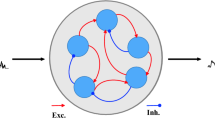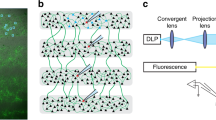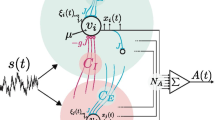Abstract
Information propagation in the cortical neural network has attracted a large amount of attention. In this paper, a feedforward network is constructed with each subnetwork being a recurrent neuronal population, consisting of neurons coupled by excitatory and inhibitory synapses, in which neurons have both types of outgoing synapses. Namely, neurons in the constructed feedforward neuronal networks have mixed excitatory–inhibitory synapses. Here, propagation of population firing rate and pulse packets are investigated. For the propagation of population firing rate, it is found that proper feedforward connection probability and strength could promote the propagation of population firing rate. Properly larger feedforward synaptic time constant could considerably enhance the fidelity of the propagating population firing rate. For the propagation of pulse packet, we find suitably adjusting the relative strength, recurrent probability, and feedforward synaptic connection can promote propagation of pulse packet. Notably, different from each other, larger feedforward synaptic time constant can considerably promote the propagation of population firing rate while hindering the propagation of pulse packets.


















Similar content being viewed by others
Notes
In our model, neurons can generate either excitatory or inhibitory synapses to their postsynaptic neurons. The phenomenon that the firing rate of the sensory network increases with R shown in Fig. 4 can be explained as follows. Take an example network of three neurons, neuron No. 1 generates stronger inhibition on neuron No. 2, so temporarily the neuron No. 2 is inhibited and then generate firing activity with a lower rate. Thus, the neuron No. 2 can only generate weaker inhibition on the neuron No. 3. making the following neurons be excited with a higher firing rate. This seems the phenomenon ‘disinhibition’ as reported in former works [80, 81]. Such disinhibition may lead to the increasing in the sensory network’s firing rate.
References
Buzsáki, G.: Neural syntax: cell assemblies, synapsembles, and readers. Neuron 68(3), 362–385 (2010)
Newsome, W.T., Britten, K.H., Movshon, J.A.: Neuronal correlates of a perceptual decision. Nature 341, 52–54 (1989)
Georgopoulos, A., Taira, M., Lukashin, A.: Cognitive neurophysiology of the motor cortex. Science 260(5104), 47–52 (1993)
Shadlen, M.N., Newsome, W.T.: Noise, neural codes and cortical organization. Curr. Opin. Neurobiol. 4(4), 569–579 (1994)
Marsalek, P., Koch, C., Maunsell, J.H.R.: On the relationship between synaptic input and spike output jitter in individual neurons. Proc. Nat. Acad. Sci. USA 94(2), 735–40 (1997)
Mazurek, M.E., Shadlen, M.N.: Limits to the temporal fidelity of cortical spike rate signals. Nat. Neurosci. 5, 463–471 (2002)
Gray, C.M.: Synchronous oscillations in neuronal systems: mechanisms and functions. J. Comput. Neurosci. 1(1), 11–38 (1994)
Riehle, A., Grün, S., Diesmann, M., Aertsen, A.: Spike synchronization and rate modulation differentially involved in motor cortical function. Science 278(5345), 1950–1953 (1997)
Diesmann, M., Gewaltig, M.O., Aertsen, A.: Stable propagation of synchronous spiking in cortical neural networks. Nature 402, 529–533 (1999)
Aertsen, A., Diesmann, M., Gewaltig, M.: Propagation of synchronous spiking activity in feedforward neural networks. J. Physiol.-Paris 90(3), 243–247 (1996)
Shadlen, M.N., Newsome, W.T.: The variable discharge of cortical neurons: implications for connectivity, computation, and information coding. J. Neurosci. 18(10), 3870–3896 (1998)
Abeles, M., Bergman, H., Margalit, E., Vaadia, E.: Spatiotemporal firing patterns in the frontal cortex of behaving monkeys. J. Neurophysiol. 70(4), 1629–1638 (1993)
Nowak, L.G., Sanchez-Vives, M.V., McCormick, D.A.: Influence of low and high frequency inputs on spike timing in visual cortical neurons. Cereb. Cortex 7(6), 487–501 (1997)
Prut, Y., Vaadia, E., Bergman, H., Haalman, I., Slovin, H., Abeles, M.: Spatiotemporal structure of cortical activity: properties and behavioral relevance. J. Neurophysiol. 79(6), 2857–2874 (1998)
McCormick, D.A., Prince, D.A.: Post-natal development of electrophysiological properties of rat cerebral cortical pyramidal neurones. J. Physiol. 393(1), 743–762 (1987)
Câteau, H., Fukai, T.: Fokker–Planck approach to the pulse packet propagation in synfire chain. Neural Netw. 14(6–7), 675–85 (2001)
Gewaltig, M.O., Diesmann, M., Aertsen, A.: Propagation of cortical synfire activity: survival probability in single trials and stability in the mean. Neural Netw. 14(6), 657–673 (2001)
Fries, P.: A mechanism for cognitive dynamics: neuronal communication through neuronal coherence. Trends Cogn. Sci. 9(10), 474–480 (2005)
Masuda, N., Aihara, K.: Bridging rate coding and temporal spike coding by effect of noise. Phys. Rev. Lett. 88, 248101 (2002)
Masuda, N., Aihara, K.: Duality of rate coding and temporal coding in multilayered feedforward networks. Neural Comput. 15, 103–125 (2003)
Masuda, N., Aihara, K.: Dual coding and effects of global feedback in multilayered neural networks. Neurocomputing 58–60, 33–39 (2004)
Bruno, R.M., Sakmann, B.: Cortex is driven by weak but synchronously active thalamocortical synapses. Science 312(5780), 1622–1627 (2006)
DeMarse, T.B., Pan, L., Alagapan, S., Brewer, G.J., Wheeler, B.C.: Feed-forward propagation of temporal and rate information between cortical populations during coherent activation in engineered in vitro networks. Front. Neural Circuits 10, 32 (2016)
Kumar, A., Rotter, S., Aertsen, A.: Conditions for propagating synchronous spiking and asynchronous firing rates in a cortical network model. J. Neurosci. 28(20), 5268–5280 (2008)
Kumar, A., Rotter, S., Aertsen, A.: Spiking activity propagation in neuronal networks: reconciling different perspectives on neural coding. Nat. Rev. Neurosci. 11, 615–627 (2010)
Barral, J., Wang, X.J., Reyes, A.: Propagation of temporal and rate signals in cultured multilayer networks. Nature Commun. 10, 1–14 (2019)
Essen, D., Anderson, C., Felleman, D.: Information processing in the primate visual system: an integrated systems perspective. Science (New York, NY) 255, 419–23 (1992)
Abeles, M.: Corticonics: Neural circuits of the cerebral cortex. Cambridge University Press, Cambridge, New York (1991)
Diesmann, M., Gewaltig, M.O., Rotter, S., Aertsen, A.: State space analysis of synchronous spiking in cortical neural networks. Neurocomputing 38–40, 565–571 (2001)
Kistler, W.M., Gerstner, W.: Stable propagation of activity pulses in populations of spiking neurons. Neural Comput. 14(5), 987–997 (2002)
van Rossum, M.C.W., Turrigiano, G.G., Nelson, S.B.: Fast propagation of firing rates through layered networks of noisy neurons. J. Neurosci. 22(5), 1956–1966 (2002)
Litvak, V., Sompolinsky, H., Segev, I., Abeles, M.: On the transmission of rate code in long feedforward networks with excitatory–inhibitory balance. J. Neurosci. 23(7), 3006–3015 (2003)
Reyes, A.D.: Synchrony-dependent propagation of firing rate in iteratively constructed networks in vitro. Nat. Neurosci. 6, 593–599 (2003)
Wang, S., Wang, W., Liu, F.: Propagation of firing rate in a feed-forward neuronal network. Phys. Rev. Lett. 96, 018103 (2006)
Kremkow, J., Aertsen, A., Kumar, A.: Gating of signal propagation in spiking neural networks by balanced and correlated excitation and inhibition. J. Neurosci. 30(47), 15760–15768 (2010)
Moldakarimov, S., Bazhenov, M., Sejnowski, T.J.: Feedback stabilizes propagation of synchronous spiking in cortical neural networks. Proc. Nat. Acad. Sci. USA 112(8), 2545–50 (2015)
Claverol-Tinturé, E., Gross, G.: Commentary: Feedback stabilizes propagation of synchronous spiking in cortical neural networks. Front. Comput. Neurosci. 9, 71 (2015)
Sornborger, A.T., Wang, Z., Tao, L.: A mechanism for graded, dynamically routable current propagation in pulse-gated synfire chains and implications for information coding. J. Comput. Neurosci. 39, 181–195 (2015)
Wang, C., Xiao, Z., Wang, Z., Sornborger, A.T., Tao, L.: A fokker-planck approach to graded information propagation in pulse-gated feedforward neuronal networks. (2015) arXiv preprint arXiv:1512.00520
Wang, Z., Sornborger, A.T., Tao, L.: Graded, dynamically routable information processing with synfire-gated synfire chains. PLoS Comput. Biol. 12(6) (2016)
Shao, Y., Sornborger, A.T., Tao, L.: A pulse-gated, predictive neural circuit. In: 2016 50th Asilomar Conference on Signals, Systems and Computers, pp. 1051–1055 (2016)
Xiao, Z., Zhang, J., Sornborger, A.T., Tao, L.: Cusps enable line attractors for neural computation. Phys. Rev. E 96(5–1), 052308 (2017)
Xiao, Z., Wang, B., Sornborger, A.T., Tao, L.: Mutual information and information gating in synfire chains. Entropy 20, 102 (2018)
Vogel, A., Ronacher, B.: Neural correlations increase between consecutive processing levels in the auditory system of locusts. J. Neurophysiol. 97(5), 3376–85 (2007)
Kimpo, R.R., Theunissen, F.E., Doupe, A.J.: Propagation of correlated activity through multiple stages of a neural circuit. J. Neurosci. 23(13), 5750–61 (2003)
Long, M., Jin, D., Fee, M.: Support for a synaptic chain model of neuronal sequence generation. Nature 468, 394–9 (2010)
Ikegaya, Y., Aaron, G., Cossart, R., Aronov, D., Lampl, I., Ferster, D., Yuste, R.: Synfire chains and cortical songs: temporal modules of cortical activity. Science 304(5670), 559–564 (2004)
Nowotny, T., Huerta, R.: Explaining synchrony in feed-forward networks. Biol. Cybern. 89, 237–241 (2003)
Segev, I.: Synchrony is stubborn in feedforward cortical networks. Nat. Neurosci. 6(6), 543–544 (2003)
Li, J., Liu, F., Xu, D., Wang, W.: Signal propagation through feedforward neuronal networks with different operational modes. EPL (Europhys. Lett.) 85(3), 38006 (2009)
Mehring, C., Hehl, U., Kubo, M., Diesmann, M., Aertsen, A.: Activity dynamics and propagation of synchronous spiking in locally connected random networks. Biol. Cybern. 88, 395–408 (2003)
Vogels, T.P., Abbott, L.F.: Signal propagation and logic gating in networks of integrate-and-fire neurons. J. Neurosci. 25(46), 10786–10795 (2005)
Kumar, A., Schrader, S., Aertsen, A., Rotter, S.: The high-conductance state of cortical networks. Neural Comput. 20, 1–43 (2008)
Jahnke, S., Memmesheimer, R.M., Timme, M.: Propagating synchrony in feed-forward networks. Front. Comput. Neurosci. 7, 153 (2013)
Jeanne, J.M., Wilson, R.I.: Convergence, divergence, and reconvergence in a feedforward network improves neural speed and accuracy. Neuron 88, 1014–1026 (2015)
Salinas, E., Sejnowski, T.J.: Correlated neuronal activity and the flow of neural information. Nat. Rev. Neurosci. 2, 539–550 (2001)
Brunel, N.: Dynamics of sparsely connected networks of excitatory and inhibitory spiking neurons. J. Comput. Neurosci. 8(3), 183–208 (2000)
Teramae, J., Fukai, T.: Local cortical circuit model inferred from power-law distributed neuronal avalanches. J. Comput. Neurosci. 22(3), 301–312 (2007)
Wang, S., Zhou, C.: Information encoding in an oscillatory network. Phys. Rev. E 79, 061910 (2009)
Guo, D., Li, C.: Population rate coding in recurrent neuronal networks with unreliable synapses. Cogn. Neurodyn. 6(1), 75–87 (2012)
Han, R., Wang, J., Yu, H., Deng, B., Wei, X., Qin, Y., Wang, H.: Intrinsic excitability state of local neuronal population modulates signal propagation in feed-forward neural networks. Interdiscipl. J. Nonlinear Sci. 25(4), 043108 (2015)
Chenkov, N., Sprekeler, H., Kempter, R.: Memory replay in balanced recurrent networks. PLoS Comput. Biol. 13, e1005359 (2017)
Eccles, J.C., Fatt, P., Koketsu, K.: Cholinergic and inhibitory synapses in a pathway from motor-axon collaterals to motoneurones. J. Physiol. 126(3), 524–562 (1954)
Root, D.H., Mejias-Aponte, C.A., Zhang, S., Wang, H.L., Hoffman, A.F., Lupica, C.R., Morales, M.: Single rodent mesohabenular axons release glutamate and gaba. Nat. Neurosci. 17(11), 1543–1551 (2014)
Uchida, N.: Bilingual neurons release glutamate and gaba. Nat. Neurosci. 17, 1432–4 (2014)
Shrivastava, A., Triller, A., Sieghart, W.: Gabaa receptors: post-synaptic co-localization and cross-talk with other receptors. Front. Cell. Neurosci. 5, 7 (2011)
Kantamneni, S.: Cross-talk and regulation between glutamate and gabab receptors. Front. Cell. Neurosci. 9, 135 (2015)
Zhang, S., Qi, J., Li, X., Wang, N., Britt, J., Hoffman, A.A., Bonci, A., Lupica, C., Morales, M.: Dopaminergic and glutamatergic microdomains in a subset of rodent mesoaccumbens axons. Nat. Neurosci. 18, 386–392 (2015)
Saunders, A., Granger, A.J., Sabatini, B.L.: Corelease of acetylcholine and gaba from cholinergic forebrain neurons. eLife 4 (2015)
Tritsch, N., Granger, A., Sabatini, B.: Mechanisms and functions of gaba co-release. Nat. Rev. Neurosci. 17, 139–145 (2016)
Granger, A., Mulder, N., Saunders, A., Sabatini, B.: Cotransmission of acetylcholine and gaba. Neuropharmacology 100, 40–46 (2015)
Zhu, H., Zou, G., Wang, N., Zhuang, M., Xiong, W., Huang, G.: Single-neuron identification of chemical constituents, physiological changes, and metabolism using mass spectrometry. Proc. Nat. Acad. Sci. 114(10), 2586–2591 (2017)
Trudeau, L.E., Hnasko, T.S., Wallén-Mackenzie, Å., Morales, M., Rayport, S., Sulzer, D.: The multilingual nature of dopamine neurons. In: Diana, M., Chiara, G.D., Spano, P. (Eds.) Dopamine, Progress in Brain Research, vol. 211. Elsevier, Amsterdam, pp. 141–164 (2014)
Hodgkin, A.L., Huxley, A.F.: A quantitative description of membrane current and its application to conduction and excitation in nerve. J. Physiol. 117(4), 500–544 (1952)
Hansel, D., Mato, G., Meunier, C.: Phase dynamics for weakly coupled hodgkin–huxley neurons. EPL (Europhys. Lett.) 23(5), 367 (1993)
Vogels, T., Abbott, L.: Gating multiple signals through detailed balance of excitation and inhibition in spiking networks. Nat. Neurosci. 12, 483–91 (2009)
Liu, Y., Li, C.: Firing rate propagation through neuronal-astrocytic network. IEEE Trans. Neural Netw. Learn. Syst. 24(5), 789–799 (2013)
Wang, X.J., Buzsáki, G.: Gamma oscillation by synaptic inhibition in a hippocampal interneuronal network model. J. Neurosci. 16(20), 6402–6413 (1996)
Li, H., Sun, X., Xiao, J.: Degree of synchronization modulated by inhibitory neurons in clustered excitatory–inhibitory recurrent networks. EPL 121, 10003 (2018)
Yang, G., Murray, J., Wang, X.J.: A dendritic disinhibitory circuit mechanism for pathway-specific gating. Nat. Commun. 7, 12815 (2016)
Wang, X.J., Yang, G.: A disinhibitory circuit motif and flexible information routing in the brain. Curr. Opin. Neurobiol. 49, 75–83 (2018)
Si, H., Sun, X.: Population rate coding in recurrent neuronal networks consisting of neurons with mixed excitatory–inhibitory synapses. Nonlinear Dyn. 100, 2673–2686 (2019)
König, P., Engel, A.K., Singer, W.: Integrator or coincidence detector? The role of the cortical neuron revisited. Trends Neurosci. 19(4), 130–137 (1996)
Thorpe, S.I., Fize, D., Marlot, C.: Speed of processing in the human visual system. Nature 381, 520–522 (1996)
Thorpe, S.J., Delorme, A., van Rullen, R.: Spike-based strategies for rapid processing. Neural Netw. 14(6–7), 715–25 (2001)
van Rullen, R., Thorpe, S.J.: Rate coding versus temporal order coding: what the retinal ganglion cells tell the visual cortex. Neural Comput. 13, 1255–1283 (2001)
Gollisch, T., Meister, M.: Rapid neural coding in the retina with relative spike latencies. Science 319(5866), 1108–1111 (2008)
Olshausen, B.A., Field, D.J.: Sparse coding of sensory inputs. Curr. Opin. Neurobiol. 14(4), 481–7 (2004)
Fries, P.: Neuronal gamma-band synchronization as a fundamental process in cortical computation. Annu. Rev. Neurosci. 32, 209–24 (2009)
Fries, P.: Rhythms for cognition: communication through coherence. Neuron 88, 220–235 (2015)
Hahn, G., Bujan, A., Fr égnac, Y., Aertsen, A., Kumar, A.: Communication through resonance in spiking neuronal networks. PLoS Comput. Biol. 10, e1003811 (2014)
Guo, D., Li, C.: Stochastic and coherence resonance in feed-forward-loop neuronal network motifs. Phys. Rev. E: Stat. Nonlinear Soft Matter Phys. 79(5 Pt 1), 051921 (2009)
Wang, Q., Zhang, H., Chen, G.: Effect of the heterogeneous neuron and information transmission delay on stochastic resonance of neuronal networks. Chaos 22(4), 043123 (2012)
Zhao, J., Qin, Y., Che, Y., Ran, H., Li, J.: Effects of network topologies on stochastic resonance in feedforward neural network. Cogn. Neurodyn. 14 (2020)
Di Maio, V., Santillo, S., Ventriglia, F.: Synaptic dendritic activity modulates the single synaptic event. Cogn. Neurodyn. (2020)
Wu, S., Zhou, K., Ai, Y., Zhou, G., Yao, D., Guo, D.: Induction and propagation of transient synchronous activity in neural networks endowed with short-term plasticity. Cogn. Neurodyn. (2020)
Acknowledgements
We thank all of the reviewers for their careful reading and creative questions and suggestions. We thank the editor’s suggestions on the figures. We thank Mr. Wenbin Liang for his effort to check and improve our English grammar and spelling.
Funding
This work was supported by the National Natural Science Foundation of China (Grant Nos. 12072046 and 11772069) and the Fundamental Research Funds for the Central University (Nos. 2018XKJC02 and 2019XD-A10).
Author information
Authors and Affiliations
Corresponding author
Ethics declarations
Conflict of interest
The authors declare that they have no conflict of interest.
Additional information
Publisher's Note
Springer Nature remains neutral with regard to jurisdictional claims in published maps and institutional affiliations.
Rights and permissions
About this article
Cite this article
Si, H., Sun, X. Information propagation in recurrent neuronal populations with mixed excitatory–inhibitory synaptic connections. Nonlinear Dyn 104, 557–576 (2021). https://doi.org/10.1007/s11071-020-06192-3
Received:
Accepted:
Published:
Issue Date:
DOI: https://doi.org/10.1007/s11071-020-06192-3




